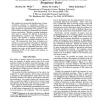85 search results - page 1 / 17 » Active machine learning for transmembrane helix prediction |
88
Voted
BMCBI
2010
15 years 1 months ago
2010
Background: About 30% of genes code for membrane proteins, which are involved in a wide variety of crucial biological functions. Despite their importance, experimentally determine...
110
Voted
ISMIS
2005
Springer
15 years 6 months ago
2005
Springer
In this paper, we adapt a statistical learning approach, inspired by automated topic segmentation techniques in speech-recognized documents to the challenging protein segmentation ...
131
Voted
BMCBI
2008
15 years 1 months ago
2008
Background: Prediction of transmembrane (TM) helices by statistical methods suffers from lack of sufficient training data. Current best methods use hundreds or even thousands of f...
107
Voted
ISMB
1993
15 years 2 months ago
1993
Weconsider tile automatedidentification of transmembrane domains in membrane protein sequences. 324 proteins (containing 1585 segrrmnts) werc examined, representing every protein ...
143
Voted
ESWA
2006
15 years 1 months ago
2006
In recent years, there have been many studies focusing on improving the accuracy of prediction of transmembrane segments, and many significant results have been achieved. In spite...



